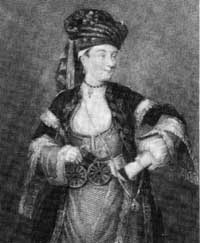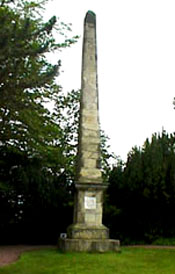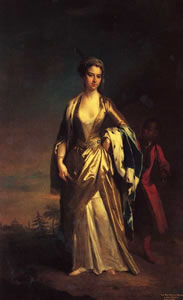Lady Mary Wortley Montagu
Poet and lady of letters
1689 - 1762

Travels to Turkey
Lady Mary Pierrepont, daughter of Evelyn, 5th Earl (later Duke) of Kingston and Marquess of Dorchester married Edward Wortley Montagu in 1712, having rejected Viscount Massereene, Clotworthy Skeffington.
Known generally as 'Mr Wortley', he was appointed Ambassador to the Court of Turkey on 7 April 1716. Taking his wife with him he became the vehicle for her discovery, in that country, of the practice of inoculation* against smallpox and so introducing it into England on their return in 1718. She had herself suffered this disease in 1715, the year in which she met Alexander Pope, through her husband.

Mr Wortley does not figure prominently in her life; it was a marriage of dubious success and they went separate ways. A man perhaps of dour temperament, his mother was from a Yorkshire family whose seat was Wortley Hall a few miles to the north of Sheffield. Wentworth Castle, near Barnsley somewhat farther north of Sheffield, has a sun obelisk in its grounds erected in 1747 by William Wentworth, 2nd Earl of Strafford (of the 2nd creation), recording her "intellectual achievements". It is said to be the only Georgian monument to a woman erected in her lifetime.
Pope becomes infatuated
Pope became infatuated with Lady Mary and his affectionate letters followed her progress across Europe: to Vienna, diverting to Hanover then to Italy, Belgrade and across Hungary to Constantinople. He even contemplated following her to Italy, first proposing a rendezvous in the Spring of 1717, and again on their return journey in the Autumn of that year.

In about 1720 Mr Wortley leased and then bought a house in Twickenham from Sir Godfrey Kneller, possibly through the agency of Pope, himself a recent arrival. This house which, according to Horace Walpole (Book of Materials), Kneller had actually occupied was later known as Savile House. It stood on the south side of Heath Lane on land now occupied by the properties lining Saville Road.
This year, too, Pope commissioned Kneller, now established in Whitton, to paint her portrait, in Turkish costume.
Mutual enmity
Relations with Pope cooled sometime during 1722, possibly on account of her friendship with Philip, Duke of Wharton who leased The Grove at the top of Cross Deep that year. By 1727, for reasons that are obscure, her friendship with Pope had turned to mutual enmity. This was given expression through the exchange of various anonymous and mutual insults. In 1729 Lady Mary mocked Pope's Grotto ("that palace placed beneath a muddy road",):
Here chose the goddess her belov'd retreat,
Which Phoebus tries in vain to penetrate,
Adorn'd within with Shells of small expense,
(Emblems of tinsel Rhyme and triffleing sense).
Perpetual fogs enclose the sacred Cave;
The neighbouring Sinks their fragrant Odours gave.
In July 1739 Lady Mary left Twickenham and England, only returning, to die, in 1762. Mr Wortley sold the house in 1758.
Footnote: The dragon of Wantley
The Wortleys were connected with the Saxon legend of the Dragon of Wantley, said to have inhabited nearby Wharncliffe Chase until slain by
"More of More Hall with nothing at all
He slew the Dragon of Wantley."
Mr Wortley had in fact inherited this name from his father, Edward Montagu, second son of the 1st Earl of Sandwich. Edward had adopted the maiden name of his wife.
*not to be confused with vaccination, introduced later by Edward Jenner.
Further reading:
Lord Wharncliffe (ed), Letters & Works of Lady Mary Wortley Montagu, 1893
Robert Halsband, The Letters of Lady Mary Wortley Montagu, 3 vols, Oxford, 1965
The Life of Lady Mary Wortley Montagu, Clarendon, 1956
Maynard Mack, Alexander Pope - A Life, Yale University Press, 1985
David Clarke, Strange South Yorkshire - Myth and Magic in the Valley of the Don, Sigma Leisure, 1994




